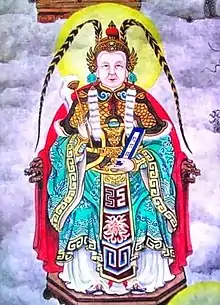Lishan Laomu
Líshān Lǎomǔ (Chinese: 驪山老母; lit. 'The old mother of Mount Li') is the goddess of Mount Li in Chinese religion.[1] She is a high-ranking female immortal in the Taoist pantheon.[2] Her origins are said to derive from Nü Wa, the legendary creator and mother goddess.[3][4]
| Lishan Laomu | |||||||
|---|---|---|---|---|---|---|---|
 The painting picture of Lishan Laomu | |||||||
| Traditional Chinese | 驪山老母 | ||||||
| Simplified Chinese | 骊山老母 | ||||||
| Literal meaning | The Old Mother of Mount Li | ||||||
| |||||||
Legends
According to legend, she is often equated with Nü Wa, as she has long been worshipped on the same mountain, but actually, Lishan Laomu has her own number of stories. Her disciples and apprentices are legendary female heroes, such as Zhong Wuyan, Fan Lihua, Bai Suzhen, Zhu Yingtai, Mu Guiying, Liu Jinding, these women are heroine era.[5]
During the Tang Dynasty, Taoist Li Quan (618-907) a commoner fond of the way of the immortals, who often travelled to spiritual places in the mountains, met with Lishan Laomu at the foot of Lishan Mountain, and Laomu taught him Huangdi Yinfujing (The Yellow Emperor's Scripture on "Unconscious Unification").[6]
The Song dynasty leishu encyclopedia Taiping Yulan quotes a Han dynasty source, the San Qinji (三秦記), and provides a legend about the first emperor of China, Qin Shi Huang, encountering the goddess at Mount Li. At the time of the First Emperor, there was a crossway of eighty li to Mount Li. People walked over the bridge, carts drove under the bridge. The pillars of metal and stone can still be seen. In the west, there are hot springs, and it is said that Qin Shi Huang played a divine woman there. As he was ill-mannered, the goddess spat at him, and an ulcer grew on that place. Struck by terror the First Emperor apologized, and the divine woman made a hot spring appear, which cured his illness. Because of that, later generations use to bath there.[7][8]
In the Shiji and Hanshu are some statements about the old mother of Mt. Lishan. She was seen as a heavenly daughter or as a woman married to a western barbarian, chieftain named Xuxuan (胥轩). Through this marriage it was able for the rulers of the Shang (17th-11th cent. BC) or Zhou (11th. cent.-221 BC) dynasties (the time is given with that period) to control the peoples in the west.[5]

Laomu's main temple is called "Lishan Laomu Palace" in Xi'an of Shaanxi Province is the most famous one among those extant temples. The palace is situated on the Xixiu Ridge of Mount Li, Lintong District, Xi'an.[9]
See also
References
- "Lishan laomu, the Old Lady from Mt. Lishan". ChinaKnowledge. Retrieved 28 August 2018.
- Yang, Lihui; An, Deming; Turner, Jessica Anderson (2008). Handbook of Chinese Mythology. Oxford University Press. ISBN 978-0-19-533263-6.
- Miller, James (2006). Chinese Religions in Contemporary Societies. ABC-CLIO. ISBN 978-1-85109-626-8.
- Chen, Fan Pen Li (2007). Chinese Shadow Theatre: History, Popular Religion, and Women Warriors. McGill-Queen's Press - MQUP. ISBN 978-0-7735-3197-0.
- "黎山老母是谁黎山老母真实身份到底是什么" (in Chinese). www.lishiquwen.com. Retrieved 28 August 2018.
- "黎山老母和观音谁级别高?黎山老母和毗蓝婆什么关系?" (in Chinese). www.todayonhistory.com. 4 January 2017. Retrieved 28 August 2018.
- 辛氏三秦記 (in Chinese). 張氏二酉堂. 1821.
- Xin, Han. – via Wikisource.
- "Lishan Laomu Palace in Xi'an". Shaanxi Radio and TV University. Retrieved 28 August 2018.